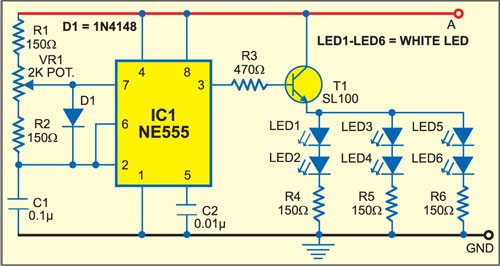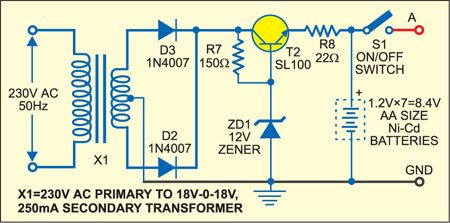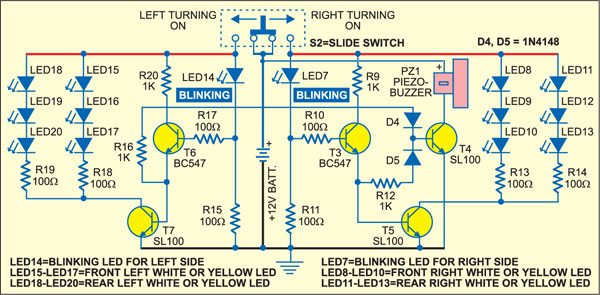 White LEDs are replacing the conventional incandescent and fluorescent bulbs due to their high power efficiency and low operating voltage. These can be utilised optimally for emergency lamp and vehicle turning indication. Presented here are white LED based emergency lamp & turning indicator circuits for the purpose.
White LEDs are replacing the conventional incandescent and fluorescent bulbs due to their high power efficiency and low operating voltage. These can be utilised optimally for emergency lamp and vehicle turning indication. Presented here are white LED based emergency lamp & turning indicator circuits for the purpose.
LED Based Emergency Lamp Circuit

Fig. 1 shows the circuit of a white-LED based emergency lamp. You can also use arrays of white LEDs as daytime running lamps in automobiles.
In the emergency lamp, seven 1.2V AA-size Ni-Cd cells giving 8.4V have been used as the power source. The brightness is controlled by duty-cycle variation of an astable multivibrator working at 1 kHz. The astable multivibrator is built around IC1. Its output is connected to LED-driver transistor T1.
Up to six branches of white LEDs can be connected in parallel, with each branch containing two LEDs in series (only three branches are used here). Depending on the application, different combinations of battery voltages and the number of LEDs in series can be made such as to keep the resistive losses low.
Charger circuit

The charger circuit for a Ni-Cd battery is shown in Fig. 2. When the battery voltage is less than 9.8V, charging takes place since the voltage at the emitter of transistor T2 (VE) is 9.8V. The value of resistor R8 is chosen such that the battery charges at a rate of 70 mA per hour. The full charge voltage of the battery is 9.8V. When the battery reaches full voltage, the current reduces to approach the tickle charge value of few milliamperes.
Assemble both the circuits shown in Figs 1 and 2 on a general-purpose PCB. LEDs can also be mounted on the reflector of a lamp. After assembling, connect points A and GND of the emergency lamp circuit to the respective points of the battery charger circuit. Now your emergency lamp is ready to work.
To use the emergency lamp, switch on the circuit using switch S1. All the LEDs (LED1 through LED6) will glow to provide sufficient light.
Turning indicator

Turning indicator shown in Fig. 3 is another application of the LEDs. It can be used for two-wheelers and draws limited power from the dynamo/battery. At low revolutions, headlight dims because of the increase in load. The white LED-based turning indicator circuit draws a fraction of the power drawn by conventional bulbs, and may last longer than the vehicle itself.
The circuit comprises two identical sections for left and right turn indications. The right turn indicator circuit is built around transistors T3 through T5 and white/yellow LEDs (LED8 through LED13). Similarly, the left turn indicator circuit is built around transistors T4, T6 and T7 and white/yellow LEDs (LED15 through LED20). Transistor T4 and the piezobuzzer are common for both-side indicators.
Circuit operation
When you slide switch S2 towards right, blinking LED7, right-front LEDs (LED8 through LED10) and rear LEDs (LED11 through LED13) start blinking. Similarly, when you slide switch S2 towards left, blinking LED14, left-front LEDs (LED15 through LED17) and rear LEDs (LED18 through LED20) start blinking.
Transistor T3 acts as the buffer, while transistor T4 drives the buzzer. Transistors T5 and T7 drive the LEDs.
The LED array can be built using white LEDs or yellow LEDs depending on the colour of the indicator’s cover. In case you use yellow LEDs, keep in mind that the forward drop voltage is around 1.8V for a single yellow LED and therefore the value of the resistance should be changed in accordance with the increase in the number of LEDs in series.
Three white LEDs produce the light intensity of six yellow LEDs.
The article was first published in July 2005 and has recently been updated.






